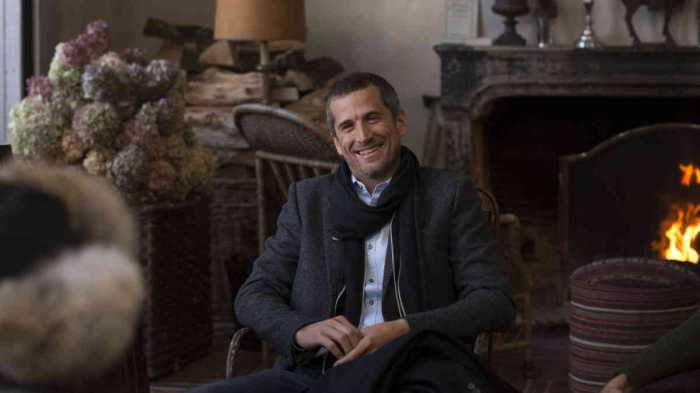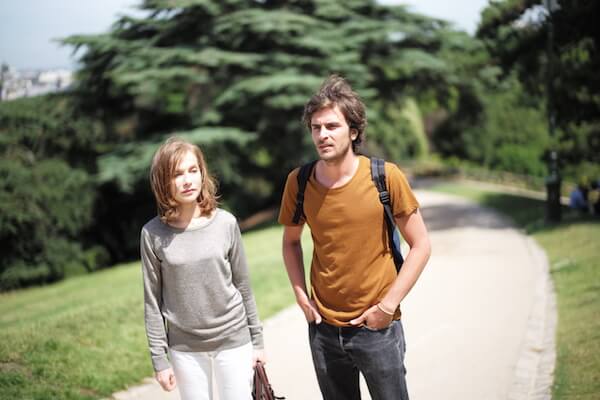Daniel Kaluuya in Jordan Peele’s “Get Out.” | UNIVERSAL PICTURES
It is common to read Baby Boomer critics writing about how their entire generation of college students went to see Bergman, Buñuel, and Godard films in the ‘60s and then spent two hours debating them over a cappuccino. I find that my experiences as a college student in the early ‘90s going to Chinatown to see John Woo and Wong Kar-wai films before they played north of Houston Street never get discussed, even if they may be shared: Hong Kong cinema would go on to have a major influence on Hollywood films like “The Matrix” and “John Wick.” Ang Lee’s “Crouching Tiger, Hidden Dragon” and Zhang Yimou’s “Hero” earned grosses in the early 2000s now unthinkable in the US for subtitled films.
But I find it telling that an Indian film, “Baahubali 2: The Conclusion,” grossed $20 million in North America and made it to number three on the American box office chart in 2017 without ever reaching an audience beyond the South Asian diaspora. In fact, only one critic I know has seen it. The AMC Empire 25, a Times Square multiplex, devotes about five of its screens to mainstream Indian and East Asian films, but it has no interest in promoting these movies to non-Asian audiences. When I went to see the Indian film “Rangoon” there last winter, its presentation was far from inviting: the lights were left on through the ads, trailers, and the feature’s first five minutes, at which point spectators got up to complain to management.
Still, such movies are reaching American audiences, while Asian arthouse films like “Harmonium” and “The Woman Who Left,” which I enthusiastically reviewed earlier this year, played for a week at the Film Society of Lincoln Center and closed.
The best, the worst, and the most undeservedly unseen
All too often, talk about diversity in American film culture is measured by Oscar nominations for mainstream cinema (a concept, that as critic Richard Brody has pointed out, builds exclusion for women, minorities, and leftist politics right into it). It should be a scandal that only three films from Africa — at a time when Nigeria has the world’s third largest movie industry! — and two from Iran were theatrically distributed in New York this year. This dismal situation motivated me enough that I got involved with curating a retrospective on Iranian director Mehrdad Oskouei, which will play next February at Anthology Film Archives. Yet once again, only two Iranian-made films, the late Abbas Kiarostami’s “24 Frames” and Sada Foroughi’s “Ava,” have US theatrical distribution lined up at this point for 2018 release.
My Top 10 List:
1. “Get Out” (Jordan Peele)
Everything I responded to in the film — the way it expresses truths about American racism and the methods by which hatred can barely cloak itself at the best of times, while being an extremely entertaining and witty horror movie with zero preachiness — seemed to be the exact same reasons it clicked with a wide audience scared by the first months of the Trump regime and wound up grossing almost $180 million. “Night of the Living Dead” director George Romero passed away this year, but “Get Out” carries on his flair for politicized genre movies.
2. “Nocturama” (Bertrand Bonello)
“Nocturama” has the audacity to create the modern equivalent of the Weather Underground or Red Army Faction, treat them sympathetically, and make state power look more dangerous and immoral. If its characters were acting in the name of Islam instead of an unstated but obvious leftism (they blow up the offices of the real-life and quite corrupt HSBC Bank), the film probably couldn’t have been made in the West. But Bonello’s exhilarating but nerve-frazzling second half, where they hole up in a shopping mall, blast Shirley Bassey, Chief Keef, and Blondie through expensive stereo systems, dress in high-end fashions, allow a homeless couple to share their food and wine, and wait for an inevitable comeuppance, suggests its real agenda: showing how impossible it is to escape capitalism’s seductions right now, even if you’re willing to set statues and offices on fire to try and break free of them.
Bertrand Bonello’s “Nocturama,” though critical of capitalism’s corruption, has a curious relationship to consumerism. | GRASSHOPPER FILM
3. “Wormwood” (Errol Morris)
Is “Wormwood” a documentary or fiction? Is it a film (it’s currently both playing the Metrograph and streaming as a mini-series on Netflix)? Considering that it tells the truth about American history via fascinating interviews, dizzying split screens, and a great performance from Peter Sarsgaard, none of that really matters much. In spirit, it’s closest to David Fincher’s “Zodiac,” raising hard questions about the impossible necessity of asking questions about murder and how to depict it. The stakes are higher here because that violence was committed by the CIA, not a crafty serial killer. This is Errol Morris’ best work in any medium since 1997’s “Fast, Cheap & Out of Control.”
4. “Personal Shopper” (Olivier Assayas)
Assayas’ second pairing with out bisexual actress Kristen Stewart ties together technology and the paranormal, suggesting that the former is moving us toward irrationality and this may not be such a bad response to grief. It’s no insult to David Lowery’s extremely accomplished “A Ghost Story” to say that I prefer the ambiguity of “Personal Shopper” to Lowery’s far blunter film. Stewart’s attempt to figure out whether her smartphone stalker is human or supernatural revisits Assayas’ first grapplings with the Internet in “demonlover” without the hysteria.
5. “Starless Dreams” (Mehrdad Oskouei)
The debut feature-length documentary by a long-ignored Iranian director led me to my first venture in programming films as well as writing about them. “Starless Dreams” offers a compassionate but harsh look at a prison for teenage girls that may be safer than many of its inmates’ homes. A lot of the details about how the girls wound up in prison — drug addiction, backgrounds of sexual and physical abuse — are probably identical to their American counterparts’, but the scene in which an imam shows up and the girls swamp him with informed questions about the many double standards around gender in Iranian law continues the tradition of challenging patriarchy in Iranian cinema.
Two teenage inmates in an Iranian prison in “Starless Dreams”. | THE CINEMA GUILD
6. “Raw” (Julia Ducournau)
This body-horror opus about a college student who turns from vegetarian to cannibal channels both early David Cronenberg and the glory days of the New French Extremity. As an allegory about the price young women have to pay in order to grow up, it resonates in numerous ways.
Garance Marillier and Rabah Nait Oufella in Julia Ducournau’s “Raw.” | FOCUS WORLD
7. “I hate myself :.)” (Joanna Arnow)
Low-cost video cameras were supposed to be empower people without access to mainstream filmmaking channels: “I hate myself :.)” was the best example of this ethos in action I saw this year, but it took four years to find American distribution and then only played New York for a week. This intensely personal documentary shows Arnow’s attempts to find her voice as an artist and sexual being under the thumb of an awful boyfriend who embodies “hipster racism” (his idea of a fun night out is going to open mic nights at Harlem comedy clubs and using slurs in front of African-Americans). She succeeded, and this excellent film was the result.
8. “The Other Side of Hope” (Aki Kaurismäki)
An old-school hipster encounters Muslim refugees and discovers that he likes them and can absorb them into his world with little difficulty. I could be describing either some of the characters in “The Other Side of Hope” or Kaurismäki himself. I can say that the political urgency of Europe’s refugee crisis and the rise of the far right have breathed new life into a Finnish filmmaker who seemed to be spending years pleasantly drifting.
9. “The Shape of Water” (Guillermo del Toro)
A genre-bending fantasy that imagines a group of underdogs, including a gay man and a literal “monster” — having a sexual relationship with a human woman — facing off against a representative of violent authoritarianism, “The Shape of Water” has clear politics. Still, it’s too concerned with playing out the mechanics of its narrative and demonstrating Guillermo del Toro’s ability to create a stylized but believable version of the early ‘60s to sink into a rote woke allegory. It does represent a clear outsider’s perspective on America’s repressive potential, for all its echoes of “Creature From the Black Lagoon” and even Clive Barker’s “Nightbreed.”
10. “Marjorie Prime” (Michael Almereyda)
Almereyda’s documentary on “Blade Runner” and “Blade Runner 2049” co-screenwriter Hampton Fancher, “Escapes,” played the IFC Center for about a week last summer. His more commercially successful sci-fi feature “Marjorie Prime” is actually a more satisfying follow-up to the themes of “Blade Runner” than its official sequel. Adapting a play by out gay writer Jordan Harrison and restricting himself most of the time to one set and four actors, Almereyda creates a vision of the end of humanity and the rise of artificial intelligence, starting as a quasi-therapeutic assist to the elderly and widowed. Aged 86 when the film was shot, Lois Smith’s turn as a woman dealing badly with her impending mortality is the year’s acting revelation.
Runners-up: “Beach Rats” (Eliza Hittman), “Behemoth” (Zhao Liang), “City of Ghosts” (Matthew Heineman), “Colossal” (Nacho Vigalondo), “Columbus” (Kogonada), “Endless Poetry” (Alejandro Jodorowsky), “Ex Libris” (Frederick Wiseman), “The Florida Project” (Sean Baker), “mother!” (Darren Aronofsky), “Mudbound” (Dee Rees), “My Friend Dahmer” (Marc Meyers), “On the Beach At Night Alone” (Hong Sang-soo), “Phantom Thread’ (Paul Thomas Anderson), “A Quiet Passion” (Terence Davies), “The Untamed” (Amat Escalante), “The Woman Who Left” (Lav Diaz).
Worst films: “Detroit” (Kathryn Bigelow), “Happy End” (Michael Haneke), “I, Tonya” (Craig Gillespie), “The Killing of a Sacred Deer” (Yorgos Lanthimos), “Slack Bay” (Bruno Dumont), “Song to Song” (Terrence Malick).
Undistributed films that deserve a week-long New York run: “Empathy” (Jeffrey Dunn Rovinelli), “Gerald’s “Game” (Michael Flanagan), “In Perfect Health” (Anca Damian), “Japanese Girls Never Die ” (Daigo Matsui), “The Road to Mandalay” (Midi-Z), “The Venerable W.” (Barbet Schroeder). Though “Gerald’s Game” played several festivals, it was produced by and for Netflix, where it is now streaming.






































